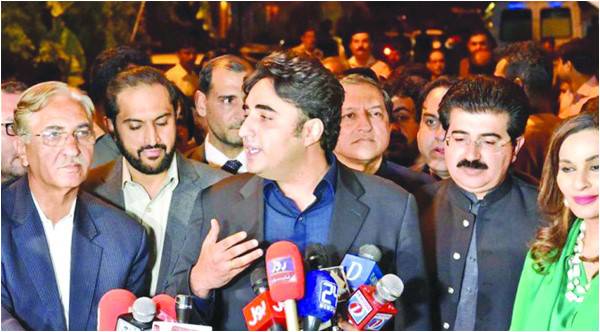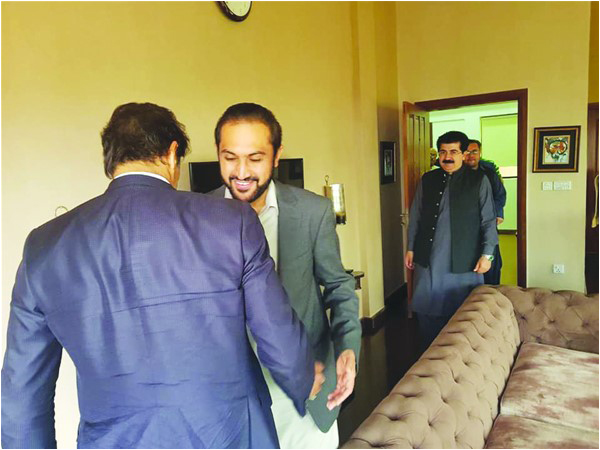
At 11:43 am on Tuesday, March 13, Punjab Chief Minister Shehbaz Sharif, who this week also became the permanent president of the ruling Pakistan Muslim League-Nawaz, tweeted out a cartoon that showed the Pakistan Tehrik-e-Insaf voting for the Pakistan People’s Party, with the caption “Naya Pakistan”.
The chief minister added his own caption to the tweet: “Recall what I used to say in 2013 that voting for PTI would be voting for Zardari ... (sic)”
The ruling party is echoing the sentiment that the PTI and PPP chiefs Imran Khan and Asif Ali Zardari have formalised an alliance to unite against the PML-N, despite the two opposition parties being at loggerheads for the past five years.
These claims have become more frequent since the election of Sadiq Sanjrani, the candidate supported by the opposition, as the Senate chairperson on Monday. The PPP and PTI backed Sanjrani, an independent candidate from Balochistan, who beat the PML-N’s Raja Zafar ul Haq 57 votes to 46, with PPP’s Saleem Mandviwalla becoming the deputy chairperson.

“Imran Khan and Zardari combined to buy their way in the Senate,” said PML-N leader and Federal Information Minister Marriyum Aurangzeb. “They eyed the independent candidates from Balochistan to continue the disruption of democracy that had begun in the Balochistan Assembly,” she added, referring to former Balochistan chief minister Sanaullah Zehri being replaced with PML-Q’s Abdul Quddus Bizenjo in January.
While the Balochistan Assembly was witnessing a reshuffle, an opposition alliance was gearing up to topple the Punjab government in what was to be an unprecedented rally in Lahore, which brought together for the first time the PTI and PPP for a common cause.
While the Mall Road dharna flopped in terms of the numbers it could muster or the demands it was to put forward – the resignations of the Punjab chief minister and law minister – it was the fact that Asif Ali Zardari and Imran Khan had come together that was the biggest talking point, even though the two never shared the stage. “What we saw were two leaders who had come together to support our cause [justice for the Model Town victims], but were wary of what it might do to their stance against one another,” said Pakistan Awami Tehreek spokesman Noor Ullah Siddiqui, referring to Khan and Zardari. “However, in this regard it was evident that Zardari was more open to joining hands, but Imran Khan too knew that the political gains are there.”
After the Lahore rally didn’t quite pay a dividend, both the PPP and PTI went their own ways, returning to the rhetoric against each other and reiterating that there was no alliance, or even common ground, between the two parties, as the focus shifted towards March’s Senate elections.
With Nawaz Sharif’s disqualification in the lead up to the March 3 Senate polls, in which the PML-N had to field independent candidates, and the PPP punching above their weight in terms of the seats won in the upper house of Parliament, both Imran Khan and Zardari had political victories to tout ahead of Monday’s election for Senate chairperson.
And it was in Sadiq Sanjrani, that the two parties found a converging point.
Zardari established his party’s position when he rejected Nawaz Sharif’s backing for the PPP’s Raza Rabbani for Senate chairperson, even saying in a press conference that Rabbani “ignored Nawaz’s violations of the Constitution and this may be the reason why Nawaz is seemingly close to (him).” For Imran Khan, Sanjrani was an opportunity to play the Balochistan card, all the while ensuring that the PML-N candidate was forestalled.
“I think it was a very smart move from Khan sahib, unlike the mishandling of the Mall Road jalsa, because not only did it ensure that the PML-N lost, it has also helped us politically penetrate Balochistan ahead of the 2018 elections,” said a PTI leader who did not want to be named.
PTI leader Ejaz Chaudhary believes the move would sell the idea that the party has solutions for the province. “It shows that the PTI wants to change the 70-year history of Balochistan and integrate those who have been marginalised for decades,” he says adding that the province with the largest area deserves to become an economic hub, owing to its natural resources and geopolitical location.
But now with the Senate elections over, and the general elections a few months away, is there a formalisation of a PPP, PTI alliance in the offing? “The PPP made it easy for us in the Senate elections by backing an independent candidate, because we would’ve found it hard to justify backing a PPP member,” said Ejaz Chaudhary. For the PPP’s Chaudhary Manzoor, the Senate chairperson was a goal that the party achieved with the help of the PTI. “Now we have our own election campaigns and then we’ll see where both parties are and where we need to come together,” he said. “It’s too soon to talk about seat adjustments. I mean, if the PPP becomes the single largest party in Parliament, we won’t need to unite with anyone, would we?”
The chief minister added his own caption to the tweet: “Recall what I used to say in 2013 that voting for PTI would be voting for Zardari ... (sic)”
The ruling party is echoing the sentiment that the PTI and PPP chiefs Imran Khan and Asif Ali Zardari have formalised an alliance to unite against the PML-N, despite the two opposition parties being at loggerheads for the past five years.
These claims have become more frequent since the election of Sadiq Sanjrani, the candidate supported by the opposition, as the Senate chairperson on Monday. The PPP and PTI backed Sanjrani, an independent candidate from Balochistan, who beat the PML-N’s Raja Zafar ul Haq 57 votes to 46, with PPP’s Saleem Mandviwalla becoming the deputy chairperson.

“Imran Khan and Zardari combined to buy their way in the Senate,” said PML-N leader and Federal Information Minister Marriyum Aurangzeb. “They eyed the independent candidates from Balochistan to continue the disruption of democracy that had begun in the Balochistan Assembly,” she added, referring to former Balochistan chief minister Sanaullah Zehri being replaced with PML-Q’s Abdul Quddus Bizenjo in January.
While the Balochistan Assembly was witnessing a reshuffle, an opposition alliance was gearing up to topple the Punjab government in what was to be an unprecedented rally in Lahore, which brought together for the first time the PTI and PPP for a common cause.
While the Mall Road dharna flopped in terms of the numbers it could muster or the demands it was to put forward – the resignations of the Punjab chief minister and law minister – it was the fact that Asif Ali Zardari and Imran Khan had come together that was the biggest talking point, even though the two never shared the stage. “What we saw were two leaders who had come together to support our cause [justice for the Model Town victims], but were wary of what it might do to their stance against one another,” said Pakistan Awami Tehreek spokesman Noor Ullah Siddiqui, referring to Khan and Zardari. “However, in this regard it was evident that Zardari was more open to joining hands, but Imran Khan too knew that the political gains are there.”
The PPP and PTI backed Sanjrani, an independent candidate from Balochistan, who beat the PML-N's Raja Zafar ul Haq 57 votes to 46, with PPP's Saleem Mandviwalla becoming the deputy chairperson
After the Lahore rally didn’t quite pay a dividend, both the PPP and PTI went their own ways, returning to the rhetoric against each other and reiterating that there was no alliance, or even common ground, between the two parties, as the focus shifted towards March’s Senate elections.
With Nawaz Sharif’s disqualification in the lead up to the March 3 Senate polls, in which the PML-N had to field independent candidates, and the PPP punching above their weight in terms of the seats won in the upper house of Parliament, both Imran Khan and Zardari had political victories to tout ahead of Monday’s election for Senate chairperson.
And it was in Sadiq Sanjrani, that the two parties found a converging point.
Zardari established his party’s position when he rejected Nawaz Sharif’s backing for the PPP’s Raza Rabbani for Senate chairperson, even saying in a press conference that Rabbani “ignored Nawaz’s violations of the Constitution and this may be the reason why Nawaz is seemingly close to (him).” For Imran Khan, Sanjrani was an opportunity to play the Balochistan card, all the while ensuring that the PML-N candidate was forestalled.
“I think it was a very smart move from Khan sahib, unlike the mishandling of the Mall Road jalsa, because not only did it ensure that the PML-N lost, it has also helped us politically penetrate Balochistan ahead of the 2018 elections,” said a PTI leader who did not want to be named.
PTI leader Ejaz Chaudhary believes the move would sell the idea that the party has solutions for the province. “It shows that the PTI wants to change the 70-year history of Balochistan and integrate those who have been marginalised for decades,” he says adding that the province with the largest area deserves to become an economic hub, owing to its natural resources and geopolitical location.
But now with the Senate elections over, and the general elections a few months away, is there a formalisation of a PPP, PTI alliance in the offing? “The PPP made it easy for us in the Senate elections by backing an independent candidate, because we would’ve found it hard to justify backing a PPP member,” said Ejaz Chaudhary. For the PPP’s Chaudhary Manzoor, the Senate chairperson was a goal that the party achieved with the help of the PTI. “Now we have our own election campaigns and then we’ll see where both parties are and where we need to come together,” he said. “It’s too soon to talk about seat adjustments. I mean, if the PPP becomes the single largest party in Parliament, we won’t need to unite with anyone, would we?”

